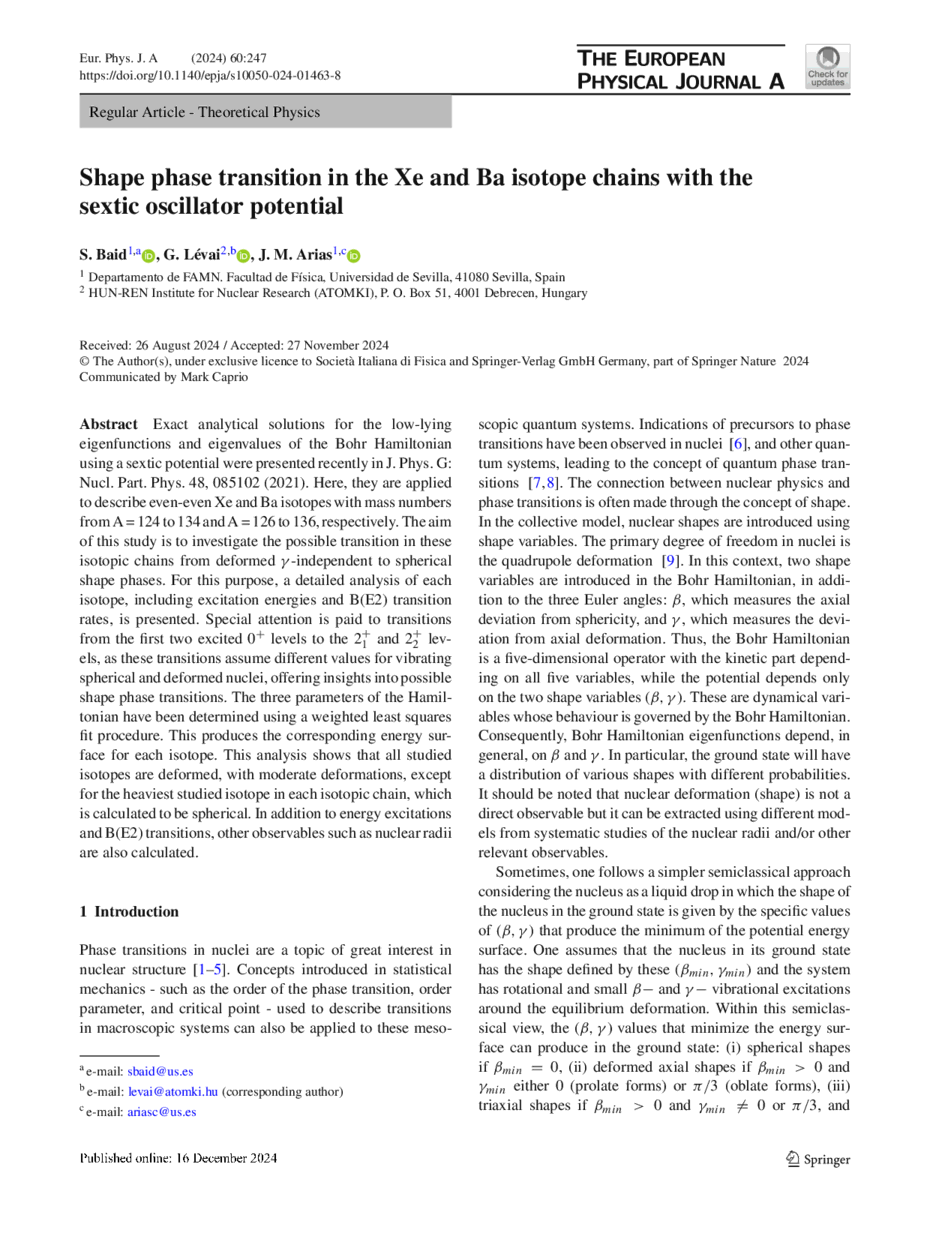https://doi.org/10.1140/epja/s10050-024-01463-8
Regular Article - Theoretical Physics
Shape phase transition in the Xe and Ba isotope chains with the sextic oscillator potential
1
Departamento de FAMN. Facultad de Física, Universidad de Sevilla, 41080, Sevilla, Spain
2
HUN-REN Institute for Nuclear Research (ATOMKI), P. O. Box 51, 4001, Debrecen, Hungary
Received:
26
August
2024
Accepted:
27
November
2024
Published online:
16
December
2024
Exact analytical solutions for the low-lying eigenfunctions and eigenvalues of the Bohr Hamiltonian using a sextic potential were presented recently in J. Phys. G: Nucl. Part. Phys. 48, 085102 (2021). Here, they are applied to describe even-even Xe and Ba isotopes with mass numbers from A = 124 to 134 and A = 126 to 136, respectively. The aim of this study is to investigate the possible transition in these isotopic chains from deformed  -independent to spherical shape phases. For this purpose, a detailed analysis of each isotope, including excitation energies and B(E2) transition rates, is presented. Special attention is paid to transitions from the first two excited
-independent to spherical shape phases. For this purpose, a detailed analysis of each isotope, including excitation energies and B(E2) transition rates, is presented. Special attention is paid to transitions from the first two excited  levels to the
levels to the  and
and  levels, as these transitions assume different values for vibrating spherical and deformed nuclei, offering insights into possible shape phase transitions. The three parameters of the Hamiltonian have been determined using a weighted least squares fit procedure. This produces the corresponding energy surface for each isotope. This analysis shows that all studied isotopes are deformed, with moderate deformations, except for the heaviest studied isotope in each isotopic chain, which is calculated to be spherical. In addition to energy excitations and B(E2) transitions, other observables such as nuclear radii are also calculated.
levels, as these transitions assume different values for vibrating spherical and deformed nuclei, offering insights into possible shape phase transitions. The three parameters of the Hamiltonian have been determined using a weighted least squares fit procedure. This produces the corresponding energy surface for each isotope. This analysis shows that all studied isotopes are deformed, with moderate deformations, except for the heaviest studied isotope in each isotopic chain, which is calculated to be spherical. In addition to energy excitations and B(E2) transitions, other observables such as nuclear radii are also calculated.
Copyright comment Springer Nature or its licensor (e.g. a society or other partner) holds exclusive rights to this article under a publishing agreement with the author(s) or other rightsholder(s); author self-archiving of the accepted manuscript version of this article is solely governed by the terms of such publishing agreement and applicable law.
© The Author(s), under exclusive licence to Società Italiana di Fisica and Springer-Verlag GmbH Germany, part of Springer Nature 2024
Springer Nature or its licensor (e.g. a society or other partner) holds exclusive rights to this article under a publishing agreement with the author(s) or other rightsholder(s); author self-archiving of the accepted manuscript version of this article is solely governed by the terms of such publishing agreement and applicable law.






